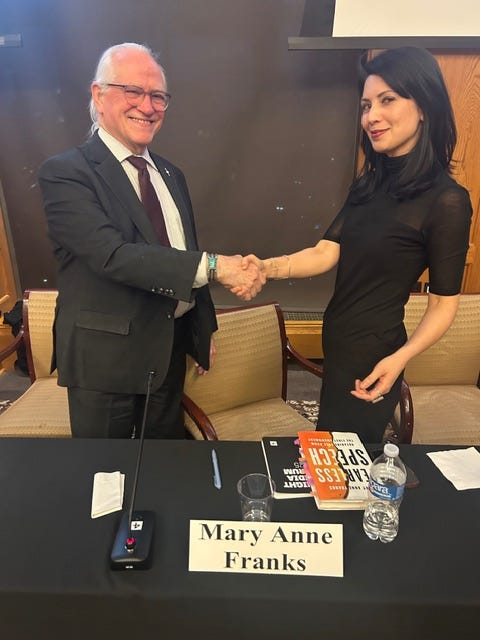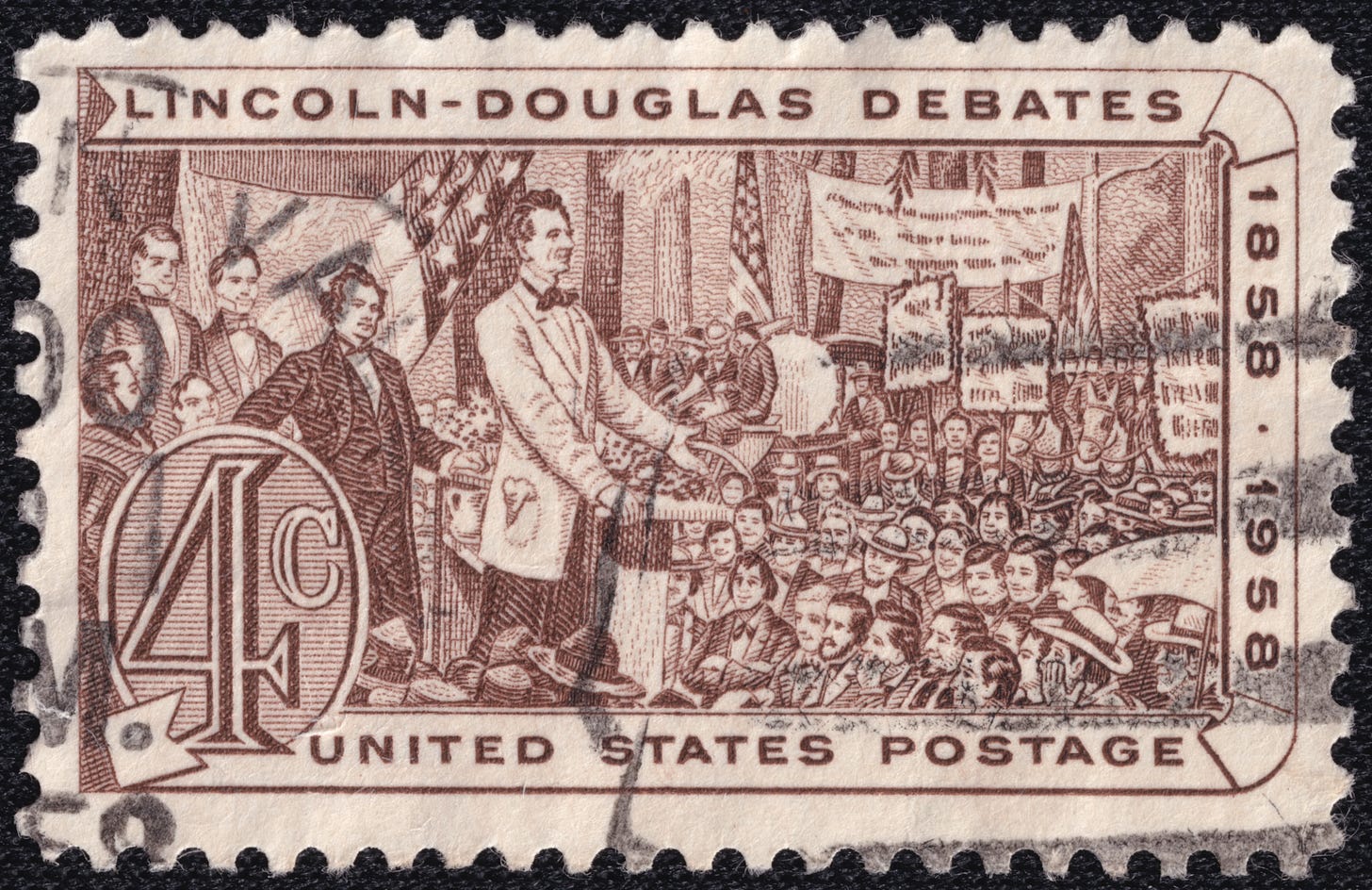Corn-Revere and Franks: When will they actually DEBATE?
First Amendment News 491

The [Cato] debate turned out to be a rather sedate affair, and I was struck by the extent Professor Franks simply declined to engage with the topic. . . [I]f Professor Franks ever wants to engage in an actual debate about her First Amendment views, I stand ready to do so.
Any time. Any place.
– Robert Corn-Revere (October 2025)
Aww. Look at them, there at the close of their Brooklyn Law School exchange: such politeness, such camaraderie, such displays of talent, and all coated with genteel smiles.
Months later, the cerebral “odd couple” — FIRE Chief Counsel Robert Corn-Revere and George Washington University Eugene L. and Barbara A. Bernard Professor in Intellectual Property, Technology, and Civil Rights Law Mary Anne Franks — ventured off to the Cato Institute for a “debate.”
Once again, their courteous manners and informed remarks drew smiles and ended in another dialogically tame exchange. If there were any meaningful philosophical disputes between them, they were largely left at the door, where their respective books were for sale.
There is, however, a chasm of free speech differences beneath the soothing smiles and genial handshakes of the FIRE lawyer and the George Washington University professor. I mean, who would have guessed that their differences were as unyielding as they actually are? Or that they were as robust as they are?
How so?
To get a taste of things, consider a recent October 2025 statement by Franks; it was posted shortly after her Cato exchange with Corn-Revere:
[FIRE is a] libertarian, far-right group . . . that is actually positioning itself to put out the fires that it started two decades ago.
That uninhibited statement (and others like it) can be found in a podcast interview that Lauren Lassabe Shepherd conducted with Franks titled “Beware of FIRE (and institutional neutrality).”
Three years ago, in an article in the Journal of Free Speech Law, Franks took targeted aim at some of the leading defenders of free speech:
[P]owerful liberal and libertarian organizations such as the American Civil Liberties Union (ACLU) and the Foundation for Individual Rights in Education (FIRE), along with mainstream and liberal-leaning publications such as The New York Times and The Atlantic, have played a significant role in deflecting attention away from conservative attacks on democracy and free expression by focusing their opprobrium on the supposed liberal excesses of political correctness, campus “safe spaces,” and now cancel culture.
Corn-Revere is in the other philosophical corner with his spare-no-punches review essay of Franks’ 2024 book Fearless Speech: Breaking Free from the First Amendment. That review, titled “Fearless Speech Ignores History to Make a Point,” is forthcoming in the Brooklyn Law Review. Among other things, in that 18,000-word, 298-footnote essay, Corn-Revere writes:
Franks’ ideas are not new, and ‘Fearless Speech’ merely recycles long-discredited critiques of free speech. Far from taking history seriously, the book simply ignores events and legal developments that contradict her thesis, and its policy prescriptions are neither new nor innovative. Worse, they make no sense. The book is careless with the facts, and its errors always tilt toward Franks’ conclusions. . .
‘Fearless Speech’ is long on attitude but short on scholarship, and it is written with a tone of superior smugness. . . Professor Franks poses as a defender of fearless speech but only manages to offer a vision of the culture and of the law that would make fearless speakers’ lives harder.
Mind you, in all of this I am not urging some kind of rude, loud, name-calling confrontation between the esteemed lawyer and the venerated professor. That said, it is something of a fraud on the public mind to watch them politely trade verbal niceties that mask the deep-seated free speech differences between them. I mean, what would the 1858 Lincoln-Douglas debates have looked like if the hearty exchange between the two gentlemen tracked the Corn-Revere/Franks diluted style?

So what say you, Corn-Revere and Franks? Are you willing to be “uninhibited, robust, and wide-open” in a point-counterpoint dialogue designed to reveal the full depth of your opposing views? Do not the free speech principles you both champion demand as much?
Pick a date, a venue, a format, and let the rich debate begin! And don’t be shy.
Related
“Sanctioned Scholars: The Price of Speaking Freely in Today’s Academy,” FIRE (October 2025)
“Mary Anne Franks targets ‘antidemocratic, racist, misogynistic, and corporate self-interest speech’ in forthcoming book,” First Amendment News 412 (Feb. 21, 2024)
Mary Anne Franks, “The Lost Cause of Free Speech,” Journal of Free Speech Law (2022)
“Mary Anne Franks: ‘[T]he narrative of widespread liberal intolerance and suppression of conservative views on college campuses is simply false,’” First Amendment News 253 (May 6, 2020)
Button up! The dangers of wearing anti-Trump buttons
Aaron Terr, “They displayed anti-Trump buttons — then the sheriff alerted Secret Service,” FIRE (Oct. 24)
When members of the Ashland County Democratic Party set up a booth at their local fair last month, they might have expected a few political disagreements. What they surely didn’t expect was to be expelled from the fairgrounds and reported to the Secret Service over buttons expressing opposition to President Donald Trump. Now, they’re suing the officials who trampled their First Amendment rights.
The booth displayed various buttons depicting red MAGA-style hats, but instead of “Make America Great Again,” they said things such as “Fascist,” “Resist,” “Felon,” and “8647” (meaning to eighty-six, or remove, the 47th president, Trump).
According to the lawsuit, the trouble started when fair officials told booth staffers they’d received complaints about two particular buttons. One read “Felon” and, beneath that, “Is he dead yet?” The other said “Fascism” and, beneath that, “One day, we will wake up to his obituary.” Officials said the buttons weren’t “family friendly” and had to go. Booth staff had already put them away, but that didn’t get them off the hook.
Related
Christopher Weber, Matthew Lee, and Rebecca Santana, “British political commentator detained by ICE at Calif. airport,” Free Speech Center (Oct. 28)
Taylor Hatmaker, “May the First Amendment be with you: Protester sues after ‘Imperial March’ performance sparks arrest,” Fast Company (Oct. 25)
Coming soon: Chemerinsky and Gillman on campus speech and academic freedom
Erwin Chemerinsky and Howard Gillman, “Campus Speech and Academic Freedom: A Guide for Difficult Times,” Yale University Press (Jan. 27, 2026)
Expert guidance for navigating the difficult new issues around free speech rights in higher education
In their earlier book, Free Speech on Campus, Erwin Chemerinsky and Howard Gillman argued that colleges and universities should permit the expression of the widest possible range of views. Nearly ten tumultuous years later, many issues have arisen that this simple principle does not adequately address.To what extent must an institution provide expensive security for extremely controversial speakers? Should colleges and universities defend faculty, students, or administrators who find themselves the victims of social media firestorms? How should they handle the expression of controversial views or the use of offensive language in classrooms? May academic departments or other administrative units—or an entire school—take positions on controversial political issues? What rules should exist around campus protests or disruptive activities? How should we assess government efforts to control faculty speech or curricular choices?
In Campus Speech and Academic Freedom, two law professors and university administrators who have confronted these questions for years draw on their extensive real-world experience to help campus leaders, campus communities, government officials, and the public better understand and address the contentious issues surrounding campus speech.
New scholarly article on campus protests
Sunita Patel, “Policing Campus Protest,” Columbia Law Review (2025)
College campuses across the country celebrate their legacies of creating free speech guarantees following student protests from the mid-1960s to early 1970s, even though colleges had minimal tolerance of such protests at the time. As part of the New Left’s vision for a different society, students, sometimes joined by faculty, demanded an end to the Vietnam War and war industry research, fought for Black and ethnic studies departments, and protested urban renewal plans that displaced Black working-class communities.
We are experiencing another transformative moment. Lawmakers and other stakeholders pressure university administrators to act against students or face funding cuts. Police repression follows, escalating into violence. Universities create or enlarge their own police or security forces in response, while also expanding codes of conduct to quash disruptive protest activity. This Symposium Piece traces the throughlines between university responses in the past and today.
This Piece also provides three features of policing campus protests. First, campus police and administrators engage in political surveillance, monitoring the political activity of the campus community, which enables universities to sanction students and faculty through campus codes of conduct and refer them for criminal prosecution. Second, police and administrators network with local and federal law enforcement agencies to share information. Third, police act formally and informally as part of the disciplinary process within universities to sanction and control protests. This Piece ends with contemporary and historic examples of university leaders who have avoided police repression as a response to student dissent and instead chosen negotiation.
More in the news
Eugene Volokh, “Virginia Court Reverses $1M Libel Judgment for School Board Chair Called ‘Sexual Predator/Harasser’ by Activist,” The Volokh Conspiracy (Oct. 28)
“ExxonMobil Sues California Over Climate Disclosure Laws,” First Amendment Watch (Oct. 27)
BrieAnna J. Frank, “Inside the ‘harsh terrain’ of Columbia University’s First Amendment predicament,” USA Today (Oct. 27)
Zoe Williams, “How the free speech debate stops us from stating the bleeding obvious,” The Guardian (Oct. 27)
Swasthi Maharaji, “Former UF law student’s expulsion for antisemitic posts ignites First Amendment battle,” Alligator (Oct. 27)
“Anti-Abortion Pregnancy Centers Are Looking To Offer Much More Than Ultrasounds and Diapers,” First Amendment Watch (Oct. 27)
“Paulson wins Voice of Freedom Award,” Free Speech Center (Oct. 24)
Greg Lukianoff, “Everyone’s a free-speech hypocrite,” FIRE (Oct. 23)
David Bauder, “After others departed, Pentagon announces ‘new’ press corps filled with conservative news outlets,” Free Speech Center (Oct. 23)
Tim Zick, “District Court Enjoins Books ‘Quarantine’ at Department of Defense Schools,” Thoughts on First (Oct. 22)
2025-2026 SCOTUS term: Free expression and related cases
Review granted: four cases
Chiles v. Salazar (argued: Oct. 7)
Olivier v. Brandon (to be argued Dec. 3)
First Choice Women’s Resource Centers, Inc. v. Platkin (to be argued Dec. 2)
National Republican Senatorial Committee v. Federal Election Commission (to be argued Dec. 9)
Pending petitions
Petitions denied
Last scheduled FAN
‘Paineful’ thoughts on dissent and protests
Tyranny, like hell, is not easily conquered; yet we have this consolation with us, that the harder the conflict, the more glorious the triumph.
This article is part of First Amendment News, an editorially independent publication edited by Ronald K. L. Collins and hosted by FIRE as part of our mission to educate the public about First Amendment issues. The opinions expressed are those of the article’s author(s) and do not necessarily reflect the opinions of FIRE.






